As I won't be able to finish the second part before Saturday, I decided to split this list in 4 parts. I hope this is in your interest. So I have a little more time and the third part will be posted on Sunday.
 | #35 Library (Base) Weighted Average: 30.19 / Median: 31 / Mode: 31 / Standard Deviation: 8.6
Highest Rank(s): #8 (1x), #14 (1x), #18 (1x) / Lowest Rank(s): #39 (2x), #41 (1x), #47 (1x)
So after this 4.1 point gap, Library is the first middle-ranked $5 card. Its weighted average is 5 points higher than its rank, showing the high density of the following cards. With a few outliers on both ends, it has a above-average deviation.
Library's best use may be countering discarding attacks as it may even set other actions aside and therefore increase the probability to draw treasures. But it's also very useful for engines with villages that don't increase your handsize, like Festival or Hamlet (that decrease it).
|
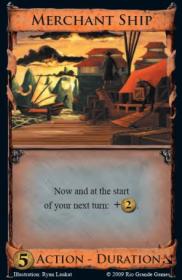 | #34 Merchant Ship (Seaside) Weighted Average: 29.29 / Median: 32 / Mode: 37 / Standard Deviation: 8.7
Highest Rank(s): #10 (1x), #14 (1x), #15 (1x) / Lowest Rank(s): #38 (1x), #39 (1x), #42 (1x)
Merchant Ship only has one rank below #40 and 6 ranks above #20. It has the highest deviation so far. Its unweighted average is on #32, new players seem to overrate it.
Merchant Ship is a very simple card. Still it is ranked very differently. While Harvest is a not guaranteed $4, this now is a guaranteed $4, just split over two turns. It's good for Big Money games as it increases the probability to have $8 early as you only need $6 in hand in the following turn. And if you manage to play one each turn, this is basically $4 every turn. The probability of colliding Merchant Ships is also lower because of the Duration effect. For all other strategies than Big Money other $5 cards are mostly stronger.
|
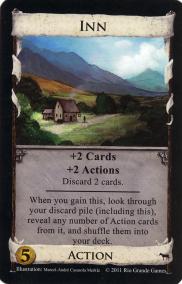 | #33 Inn (Hinterlands) Weighted Average: 28.95 / Median: 30.5 / Mode: 27 / Standard Deviation: 7.2
Highest Rank(s): #11 (1x), #14 (1x), #19 (1x) / Lowest Rank(s): #40 (3x)
The consensus on Inn is higher; most of the following cards have higher deviation. It's the first card with no rank below #40.
Inn's main effect is pretty simple too. It's a Young Witch with no attack effect, but +2 Actions instead. So it's a village that doesn't increase handsize, but has a filter effect. This is nice but not great. More important is its on-buy effect. Shuffling action cards into the draw pile is great when you time it right, especially when there are (nearly) no cards in the draw pile. Decks with high action density love Inn, so you can prepare a Scrying Pool mega-draw for example. If you manage to have enough money and at least an extra-buy with your actions, you can buy a Inn from the extra-buy and won't see your bought victory cards so fast, especially in combination with Chancellor. Even if you don't necessarily have a high action density and miss $8, buy a Inn for getting all your nice actions in the next turn. You can even easily set up a King's Court/Bridge hand.
|
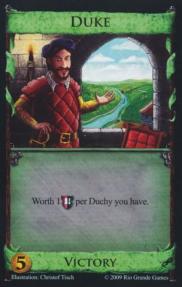 | #32 Duke (Intrigue) Weighted Average: 28.89 / Median: 33 / Mode: 38 / Standard Deviation: 11.4
Highest Rank(s): #8 (2x), #9 (1x) / Lowest Rank(s): #42 (1x), #43 (1x), #45 (1x)
Duke is the best example for my statement "Victory cards are difficult to rank". It has the highest deviation of all $5 cards with 3 times above #10, 5 times above #20 and 6 times below #40. If we take the unweighted ranking into account it would be on #34, but experienced players saved 2 ranks. It was close though, only 0.06 points are between Duke and Inn.
Duke is similar to Silk Road and Gardens Rushes as you need to get the Duchies and Dukes as fast as you can. So you need similar good supporter cards which help getting $5 even if you're already greening, like Vault, Hoard, Duchess, Horse Traders to name a few. Duke can be very strong as it can easily be worth 6-8 VP if your opponent doesn't deny your strategy and is better than Province in those cases. 3-piling isn't that hard afterwards as there are 2 piles already gone. The problem is to realize when a board is a good Duke board. With good attacks (Curser and Handsize-Reducer) you probably want those attacks instead and ignore Duchies/Dukes and go directly for Provinces.
|
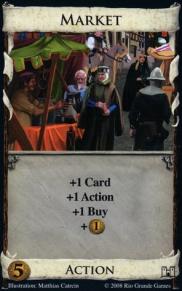 | #31 Market (Base) Weighted Average: 28.49 / Median: 28 / Mode: 27 / Standard Deviation: 6.2
Highest Rank(s): #13 (1x), #15 (1x), #22 (1x) / Lowest Rank(s): #34 (2x), #38 (1x), #45 (1x)
After Duke with the highest deviation follows Market, the card with the lowest deviation of all middle-ranked cards. It was only 2 times above #20 and one time below #40.
You probably pick up Market at least once in most of the games, but it is no super strong card. You want it most of the times because of the cantrip +Buy as an addition to your main strategy, because +Buy cantrips are rare and you may already have stronger terminal cards. And it is also superior to Silver in all but Big Money games as you draw a card and get an additional $1. The non-terminal +Buys is very important in some combos too, like a Highway+Market chain. Market usually is no good opener, but Market/Chapel is very strong and is on #41 of the best openings.
|
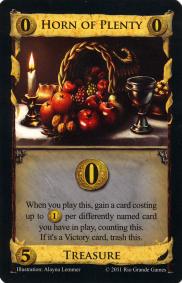 | #30 Horn of Plenty (Cornucopia) Weighted Average: 27.85 / Median: 30 / Mode: 32 / Standard Deviation: 9.0
Highest Rank(s): #3 (1x), #10 (1x), #15 (1x) / Lowest Rank(s): #39 (2x), #40 (1x), #44 (1x)
Horn of Plenty is another card with high variance. It has a really big outlier on #3 and it was 4 times above #20.
Horn of Plenty is one of the cards that are very hard to master. On average boards it's similar to Ironworks and just too slow. But if you can build a decent engine with several different cards involved (and that is the hardest part), then HoP is very powerful. With one Horn of Plenty and a good engine the game can end in 3 turns. Turn 1: Gain another HoP, Turn 2: Gain another 2 HoPs, Turn 3: Gain 4 Provinces from the HoPs and buy the 5th Province with the rest of your money: Basically "Game Over". The problem is to build such an engine and prepare the Mega Turn before the opponent gets a too big Province lead.
|
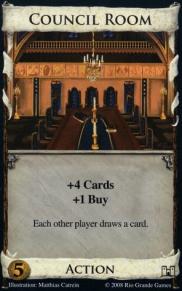 | #29 Council Room (Base) Weighted Average: 27.59 / Median: 28 / Mode: 25 / Standard Deviation: 7.4
Highest Rank(s): #11 (1x), #14 (1x), #17 (1x) / Lowest Rank(s): #39 (2x), #41 (1x)
Council Room is really mediocre, the consensus was pretty high and only 4 ranks were above #20.
Council Room is really strong per se, but don't underestimate the extra card for your opponent. If he draws a Gold or the much needed village for his own Council Room, he may even profit more from your play than you do. It really only shines on boards with discard attacks like Militia or Goons. With such cards you take back the profit from your opponent and have a really big hand and even a +Buy. Its drawing power and +Buy makes it a good Level 3 opener combined with Fool's Gold.
|
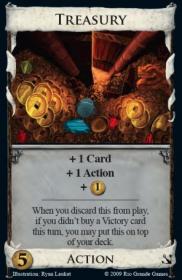 | #28 Treasury (Seaside) Weighted Average: 26.88 / Median: 25 / Mode: 24 / Standard Deviation: 9.1
Highest Rank(s): #7 (1x), #12 (2x) / Lowest Rank(s): #39 (2x), #47 (1x)
Treasury has a deviation with big outliers on both sides: #7 and second last. It was 6 times above #20.
Similar to Market, it's a "Copper that doesn't hurt", this time without the +Buy but with top-decking ability. As you can only use this ability until you're going green, you want Treasuries very early. Of course Treasury/Chapel is even better than Market/Chapel on #18 of the best openings. With 2-3 Treasuries you can keep buying good cards every turn. This comboes well with Outpost. But Treasuries are very slow, too slow on most boards. They're therefore better in Colony games and in all other games that tend to be slow. But beware of discarding attacks if you have more than 3 Treasuries. Treasury is especially good in greenless games like with Bishop or Goons. You can then keep top-decking them even until the late game.
|
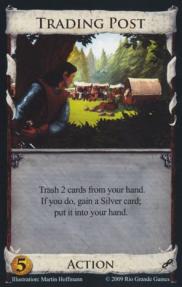 | #27 Trading Post (Intrigue) Weighted Average: 25.95 / Median: 24.5 / Mode: 36 / Standard Deviation: 7.2
Highest Rank(s): #13 (1x), #14 (1x), #16 (2x) / Lowest Rank(s): #36 (3x)
It has the "best worst rank" so far with no-one ranking it worse than #36. And this is even its mode with being voted on #36 3 times.
Trading Post is another card in the category "Good opener, but afterwards". The deviation is surprisingly low for that. Maybe because it costs $5 and is only a important opener in about 1-(5/6)^2 ~ 30% of all 2-player games. But with 10 openings in the Top 100 of all openings (with Trading Post/Lighthouse on #9 and Trading Post/Haven on #11), that still shows its strength. If you compare its ability with Mine as a opener: It can trash 2 instead of one card and it can trash all card types and isn't limited to treasures. But Trading Post has fiercer competition in the $5 list, so its downside of getting weak soon was taken more into account by all of you. And of course its a little bit weaker in Colony games.
|
 Author
Topic: The Best Dominion Cards List 2012 Ed.1: $5 cards (Read 130861 times)
Author
Topic: The Best Dominion Cards List 2012 Ed.1: $5 cards (Read 130861 times)
